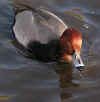|
|
Description
Early in its history the Redhead suffered from identity crises. Ornithologists (even the well-known Audubon and Wilson) identified it as being identical to the Common Pochard – a European duck. It wasn’t until later that it was recognized as being a distinct North American species.
The identity crisis of Redheads is carried over into the present day. Male Redheads can be confused with Canvasbacks as they both sport a distinctive chestnut/red head. However, on closer inspection you can see that instead of the elegantly sloping forehead and long beak of the Canvasback, Redheads have an abrupt forehead and a short broad blue bill with a dark tip.
Drake Redheads have a reddish head and upper neck. Their lower neck,
fore back and breast is black while the back is a dark grayish
color. They have a broad band of light grey extending across their wing and on to the primaries.
Females have a duller, reddish brown head, neck and breast. Their bill is a duller blue than the males. Their chin and throat are a buff white. They also have a very faint eye ring and stripe behind the eye. Flanks are breast are brown. Female Redheads can be mistaken for Ring-necks at a distance.
|
|
Breeding
Redheads are considered ‘over-water nesters’. That
is, their nests are found on mats of vegetation in
shallow water. Again, there are exceptions to
this rule and the occasional nest is found in the
uplands. Their bulky nests of reeds/cattail
blades padded with breast down contain an average of
10-15 eggs. Hens lay one egg a day until the clutch is
complete. Only hens incubate the eggs.
After the last egg is laid it is 25 days until the
eggs start to hatch.
In captivity the drakes will pair successfully with more than one hen.
|
|
General Comments
Romance for the Redhead begins late in the winter
with several males competing for one or two females.
Male Redheads go through complex display behaviors to
prove to the females how attractive they are. For
instance, in one gymnastic like display, the male
throws back his head until his crown nearly touches
his tail feathers. Along with physical displays, the
males can also be heard making a ‘meowing sound’
to attract females.
The Redhead has the habit of passing off the duty
of parental care to others by laying eggs in other
Redhead nests, and even in other duck nests such as
the Canvasback. Thus, leaving the care and
raising of their young to others. This behavior
(parasitism) tends to occur more often when breeding
conditions are poor (e.g. a drought year).
|
|
Place Mouse over Pictures to Enlarge

Redhead Drake

Redhead Hen

Redhead Pair
How
to Order
|